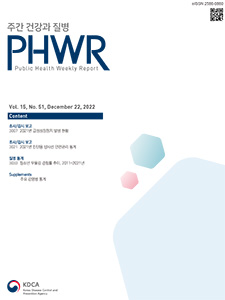Current Issue
Vol.15 No.51, December 22, 2022
-
Surveillance Reports 2022-12-22
 7
7
 939
939
 150
150
Incidences of Out-of-hospital Sudden Cardiac Arrest in the Republic of Korea, 2021
Jisu Kim, Jihyun Jeong, Sanghui Kweon*
Public Health Weekly Report 2022; 15(51): 3007-3020 https://doi.org/10.56786/PHWR.2022.15.51.3007 Abstract
AbstractThe Korea Sudden Cardiac Arrest Survey has been conducted annually, which could be support to make and evaluate policy for the prevention and treatment of sudden cardiac arrest. Based on the first aid activity log of 2021, 33,235 cases of out-of-hospital sudden cardiac arrest occurred in the Republic of Korea. The rate of sudden cardiac arrest in men was higher than that in women, and 53.3% of the cases were among individuals aged 70 years and over. There were 7,638 cases in Gyeonggi, which the highest number among cities and provinces, Jeju was the highest region in the rate of sudden cardiac arrest (101.8 persons per 100,000 population). The survival rate in 2021 was 7.3%, similar to 7.5% in 2020, while the rate in 2019 was 8.7%, higher than that in 2020 and 2021. The survival rate of patients with cardiopulmonary resuscitation (CPR) by bystanders was 11.6%, relatively high compared to cases without CPR by bystanders. The rate of patients with CPR by bystanders was 28.8% in 2021, which has been increased annually, and the rate of Seoul was 44.0%, the highest level among cities and provinces. The rate of brain function recovery in 2021 was 4.4%, which was lower than that in 2019, similar to the rate of survival. The rates of survival and brain function recovery should be elevated to the level before the pandemic of the coronavirus disease 2019, and the strategies to control the quality of CPR might be concerned.
-
Surveillance Reports 2022-12-22
 1
1
 520
520
 267
267
Status of Diagnostic X-ray Equipment in the Republic of Korea, 2021
Seung-Ki Song, Jong-Won Gil, Byeong-Young Lee*
Public Health Weekly Report 2022; 15(51): 3021-3032 https://doi.org/10.56786/PHWR.2022.15.51.3021 Abstract
AbstractA continuous increase has been observed in the number of diagnostic X-ray machines in the Republic of Korea, from 89,955 in 2019 to 97,745 in 2021. Classification based on the types of X-ray equipment showed that the portion of general equipment with an integrated tube-high voltage (HV) generator used in radiography or fluoroscopy accounted for the largest proportion (26%, 25,000), followed by general equipment with separate tube-HV generator (22%; 21,237), intra-oral equipment (14%; 14,136), equipment for panoramic imaging (7%; 7,332), dental computed tomography (CT) (15%; 14,663), equipment for bone mineral densitometry (9%; 9,154), mammography equipment (4%; 3,702), and whole body CT equipment (3%; 2,521). The district-based categorization revealed that Seoul had the largest number of diagnostic X-ray machines (22.9%; 22,362), while Sejong had the smallest number (0.6%; 544). Based on the period of use, 35.4% (34,643) of total equipment had been used for 5 years or less. As the number of diagnostic X-ray equipment increases, the importance of safety management in medical radiation will also increase and more efforts will be required to ensure radiation safety.
-
QuickStats 2022-12-22
 0
0
 3629
3629
 725
725
Trends in Prevalence of Felt Depression among Korean Adolescents, 2011–2021
Public Health Weekly Report 2022; 15(51): 3033-3034 https://doi.org/10.56786/PHWR.2022.15.51.3033

pp. 1433~1461
Most Keyword
?
What is Most Keyword?
- It is the most frequently used keyword in articles in this journal for the past two years.
Most Read
-
Waterborne and Foodborne Disease Outbreaks in the Republic of Korea, 2023
Myung-Jae Hwang, So Yeon Park, Hyungjun Kim, Se Jeong Yang, Sungchan Yang, Jin Seon Yang
Public Health Weekly Report 2025;18: 17-32 https://doi.org/10.56786/PHWR.2025.18.1.2 -
Implementation Plan for the Coronavirus Disease 2019 Vaccination for the 2024–2025 Season: Recommendations of the 6th Expert Committee on Immunization Practices
Hyewook Hwang, Wookeon Lee, Seohyeon Ahn, Young-Sook Choi, Seunghyun Lewis Kwon, Dongwoo Lee, Eun Hwa Choi, SokGoo Lee
Public Health Weekly Report 2025;18: 90-102 https://doi.org/10.56786/PHWR.2025.18.2.3
Editorial Office
+82-43-719-7569





 Full Text
Full Text Cite
Cite


